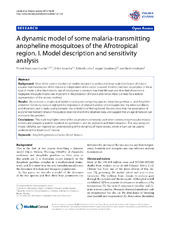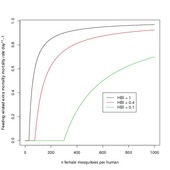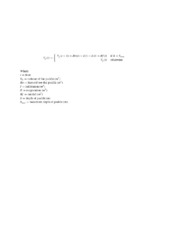| dc.contributor.author | Lunde, Torleif Markussen | en_US |
| dc.contributor.author | Korecha, Diriba | en_US |
| dc.contributor.author | Loha Shumbullo, Eskindir | en_US |
| dc.contributor.author | Sorteberg, Asgeir | en_US |
| dc.contributor.author | Lindtjørn, Bernt | en_US |
| dc.date.accessioned | 2013-10-28T12:42:39Z | |
| dc.date.available | 2013-10-28T12:42:39Z | |
| dc.date.issued | 2013-01-23 | eng |
| dc.Published | Malaria Journal 12(1):28 | eng |
| dc.identifier.issn | 1475-2875 | |
| dc.identifier.uri | https://hdl.handle.net/1956/7437 | |
| dc.description.abstract | Background: Most of the current biophysical models designed to address the large-scale distribution of malaria assume that transmission of the disease is independent of the vector involved. Another common assumption in these type of model is that the mortality rate of mosquitoes is constant over their life span and that their dispersion is negligible. Mosquito models are important in the prediction of malaria and hence there is a need for a realistic representation of the vectors involved. Results: We construct a biophysical model including two competing species, Anopheles gambiae s.s. and Anopheles arabiensis. Sensitivity analysis highlight the importance of relative humidity and mosquito size, the initial conditions and dispersion, and a rarely used parameter, the probability of finding blood. We also show that the assumption of exponential mortality of adult mosquitoes does not match the observed data, and suggest that an age dimension can overcome this problem. Conclusions: This study highlights some of the assumptions commonly used when constructing mosquito-malaria models and presents a realistic model of An. gambiae s.s. and An. arabiensis and their interaction. This new mosquito model, OMaWa, can improve our understanding of the dynamics of these vectors, which in turn can be used to understand the dynamics of malaria. | en_US |
| dc.language.iso | eng | eng |
| dc.publisher | BioMed Central | eng |
| dc.relation.ispartof | <a href="http://hdl.handle.net/1956/7442" target="blank">On the dynamics of two efficient malaria vectors of the Afrotropical region: Anopheles gambiae s.s. and Anopheles arabiensis</a> | eng |
| dc.rights | Attribution CC BY | eng |
| dc.rights.uri | http://creativecommons.org/licenses/by/2.0/ | eng |
| dc.subject | Anopheles gambiae complex | eng |
| dc.subject | Model | eng |
| dc.subject | Malaria | eng |
| dc.title | A dynamic model of some malaria-transmitting anopheline mosquitoes of the Afrotropical region. I. Model description and sensitivity analysis | en_US |
| dc.type | Peer reviewed | |
| dc.type | Journal article | |
| dc.date.updated | 2013-08-23T08:55:37Z | |
| dc.description.version | publishedVersion | en_US |
| dc.rights.holder | Copyright 2013 Lunde et al.; licensee BioMed Central Ltd. | |
| dc.rights.holder | Torleif Lunde et al.; licensee BioMed Central Ltd. | |
| dc.identifier.doi | https://doi.org/10.1186/1475-2875-12-28 | |
| dc.identifier.cristin | 1009042 | |
| dc.source.journal | Malaria Journal | |
| dc.source.40 | 12 | |
| dc.source.14 | 1 | |
| dc.source.pagenumber | 28- | |





